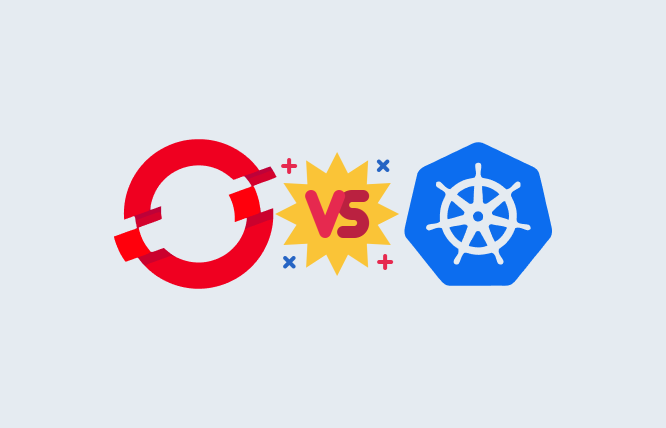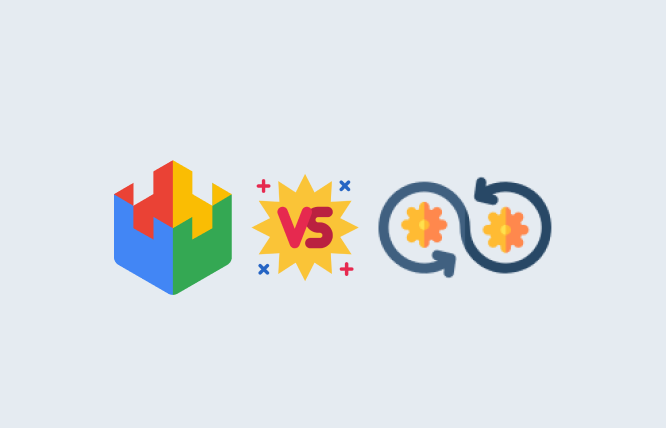Introduction
This blog post compares OpenShift vs Kubernetes, two container orchestration tools. It helps businesses choose the right tool based on factors like security, ease of use, and integrations.
The container orchestration market is experiencing substantial growth, with a projected market size to generate $18.8 billion by 2027, according to a report by Grand View Research. When we talk about the best orchestration tools there are two options OpenShift vs Kubernetes.
Before delving in further, you must know that containerisation has significantly transformed businesses. Containers bundle microservices into portable, lightweight entities. However, efficiently managing these containers on a large scale requires a robust tool: container orchestration. This is where OpenShift vs Kubernetes become crucial technologies for managing containerised applications. With two powerful competitors, which one comes out on top? Let’s start discussing the fundamentals.
Kubernetes is a freely available platform that offers essential resources for managing applications in container form. It is strong and adaptable, but you must configure and incorporate extra elements such as security, networking, and developer tools.
OpenShift, developed by Red Hat, is a paid container platform that is based on Kubernetes. It provides a more convenient user experience with included security measures, tools for developers, and pre-incorporated features for networking and storage. Deploying and managing containerised applications is simplified with this approach, yet it has limitations and is not as flexible as Kubernetes.
Ultimately, the best tool among Kubernetes vs Openshift will depend on your specific needs. Keep reading to explore the key differences and discover which one best suits your development journey.
What is Container Orchestration?
Container orchestration is like conducting an orchestra. It’s a system that helps manage and coordinate multiple containers, making sure they run smoothly and work together effectively.
Consider managing a vast data centre containing several virtual machines (VMs) that are operating as separate microservices. In order to guarantee efficient functioning and the best use of resources, a central management platform (container orchestration tool) is necessary. This system automates duties such as setting up VMs (containers), adjusting resources (increasing VMs during busy times), and enabling communication between them (networking). In the same way, container orchestration automates the deployment, scaling, and networking of containerised applications to ensure seamless collaboration of all microservices.
What is Kubernetes and its Benefits?
Kubernetes is like a manager for your containers. It helps you deploy, manage, and scale your containerised applications. Its benefits include easier management, scalability, and flexibility for your applications. Here are some of its key benefits:
- Scalability: Easily scale your applications up or down based on demand.
- High Availability: Kubernetes ensures your application remains online even if individual containers fail.
- Portability: Deploy your containerised application anywhere – on-premises, in the cloud, or in a hybrid environment.
Container Orchestration Breakdown: OpenShift vs Kubernetes
In the dynamic world of cloud computing, containerisation has emerged as a transformative technology for businesses. It allows microservices and self-contained application components to be packaged into lightweight, portable units. However, managing these containers efficiently at scale necessitates a powerful tool: container orchestration. This is where OpenShift and Kubernetes enter the scene. Both are powerhouses, but which one reigns supreme for your needs?
Here’s a quick comparison:
| Feature | OpenShift | Kubernetes |
| Base | Built upon Kubernetes | Open-source container orchestration platform |
| Focus | Enterprise container platform | Core container orchestration engine |
| Cost | Subscription-based model | Free, open-source software |
| Security | Built-in security features (RBAC, network isolation) | Requires additional configuration |
| Ease of Use | User-friendly web console, developer tools | Steeper learning curve, requires expertise |
| Integrations | Integrates with business management solutions | Limited built-in integrations |
How OpenShift extends Kubernetes
Think of OpenShift as Kubernetes with enhanced capabilities. It builds upon the core functionality of Kubernetes, adding features specifically designed for enterprise use cases. Here’s what sets OpenShift apart:
- Security is a top priority for OpenShift, demonstrated through built-in functionalities such as role-based access control and network isolation.
- OpenShift provides a browser-based dashboard and tools for developers, simplifying the process of application development.
- Integration with Business Management Solutions: OpenShift effortlessly connects with current business management tools, creating a unified IT environment.
Understanding the Similarities
Prior to delving into the details, it is crucial to recognise the similarities that exist between OpenShift and Kubernetes. Both have strong and expandable structures that facilitate fast and large-scale development, deployment, and management of applications. Moreover, they also have the same open-source license (Apache License 2.0).
Key Differences to Consider
Now, let’s delve into the key differences that set these two container orchestration tools apart:
Deployment
Kubernetes offers more flexibility as an open-source platform. It is compatible with virtually all platforms, including major cloud providers such as Microsoft Azure and AWS, as well as various Linux distributions. In contrast, OpenShift is linked to Red Hat’s environment, needing Red Hat Enterprise Linux Atomic Host (RHELAH), Fedora, or CentOS. This can restrict choices for companies that have not already put resources into those platforms.
Integrated CI/CD
Neither platform offers a complete CI/CD solution out of the box. Kubernetes can be paired with additional tools for automated monitoring, testing, and CI servers. OpenShift offers a certified Jenkins container that functions as a continuous integration server.
Image Registry Management
Kubernetes doesn’t have an integrated image registry, although it allows pulling images from private registries. OpenShift provides a built-in image registry that seamlessly integrates with DockerHub and Red Hat, allowing developers to leverage image streams for effortless image management.
Support
Kubernetes benefits from a large and active developer community that is constantly working on improvements. It also offers support for multiple frameworks and languages. OpenShift has a smaller support community primarily focused on Red Hat developers.
Networking
Kubernetes lacks a built-in networking solution, relying on third-party plug-ins. OpenShift offers a more user-friendly experience with its built-in Open vSwitch networking solution and three native plug-ins.
Security
OpenShift prioritises security. It enforces stricter policies, such as not allowing containers to run as root by default. Additionally, it offers a “secure-by-default” option for enhanced protection. Kubernetes, on the other hand, requires more manual configuration for authentication and authorisation.
Releases and Updates
Kubernetes releases updates more frequently, averaging four releases per year compared to OpenShift’s three. Additionally, Kubernetes allows for simultaneous updates, while OpenShift DeploymentConfig does not.
Templates
Kubernetes offers Helm templates, which are known for their ease of use and flexibility. OpenShift templates are generally considered less user-friendly and offer less flexibility.
User Experience and Interface
Kubernetes can be intimidating for beginners due to its complex web interface. Users need to install additional components for a graphical interface and manage authentication tokens. OpenShift offers a more user-friendly web console, streamlining the experience.
Openshift vs Kubernetes Cost
The cost of OpenShift and Kubernetes differs significantly:
Kubernetes – Being open-source, it is free to use. However, there are associated costs to consider:
- Infrastructure: Running Kubernetes requires setting up and managing your own infrastructure, including servers, storage, and networking. This can be expensive, especially for large-scale deployments.
- Expertise: Kubernetes has a steeper learning curve. You may need to hire skilled professionals to manage and maintain your Kubernetes clusters.
- Managed Services: Many cloud providers offer managed Kubernetes services, which take care of the infrastructure and some management tasks. These services are convenient but come with a subscription fee.
OpenShift is a commercial product from Red Hat. It offers a more user-friendly experience with built-in features on top of Kubernetes. This convenience comes at a cost:
- Subscription Fees: Red Hat charges subscription fees for OpenShift, which can vary depending on the features you need and the deployment model (on-premises, cloud, etc.).
- Vendor Lock-In: Using OpenShift can lead to some vendor lock-in, as some features and tools are specific to the Red Hat ecosystem.
Choosing the Right Container Orchestration Tool
The optimal choice between OpenShift and Kubernetes hinges on your specific requirements. Here are some key considerations:
- Team Expertise: If your team possesses extensive Kubernetes knowledge, managing a Kubernetes cluster directly might be cost-effective. However, consider the ongoing need for Kubernetes consulting services to maintain and optimise the cluster.
- Application Complexity: For intricate, mission-critical applications, OpenShift’s robust security features and enterprise support might be a worthwhile investment.
- Development Workflow: If your development process heavily relies on web-based tools and seamless integration with existing business solutions, OpenShift offers a smoother experience.
Conclusion
OpenShift and Kubernetes are both effective tools for orchestrating containers. By recognising their unique advantages and limitations, you can make a well-informed choice that supports your growth initiatives and drives your business ahead.
However, if you are not technically sound, then consult with experts who can provide full-scale containerisation services. Remember, regardless of whether you require custom mobile app development, web application development, or comprehensive enterprise technology solutions, containerisation with the right orchestration tool can revolutionise your IT infrastructure.
Frequently Asked Questions
Both OpenShift and Kubernetes are powerful tools for container orchestration, but they cater to different needs. Kubernetes is an open-source foundation offering core functionalities for managing containerised applications. It requires additional setup for features like security and networking. OpenShift, built on Kubernetes by Red Hat, is a user-friendly platform with these features pre-integrated, making it easier to deploy and manage applications. However, OpenShift comes with a subscription fee.
Choose Kubernetes if: You have a small, simple deployment and in-house expertise to manage the infrastructure. You prioritise vendor neutrality and complete customisation. Choose OpenShift if: You need a faster and easier way to deploy and manage containerised applications. You value built-in security, developer tools, and a user-friendly experience. You’re willing to pay a subscription fee for these conveniences.
Kubernetes itself is free to use, but running it involves costs like infrastructure, potentially hiring skilled personnel, or subscribing to managed services offered by cloud providers. OpenShift has a subscription fee from Red Hat, which varies based on features and deployment model. While it simplifies management, it adds a recurring cost.
Absolutely! Futurbyte is a full-scale software solutions provider offering expertise in microservices design and development. We help businesses leverage the power of containerisation with web and application developer skills and a deep understanding of enterprise technology solutions like Kubernetes and OpenShift. Whether you need help choosing the right tool, deploying your application, or managing your containerised infrastructure, Futurbyte can be your one-stop shop for success. Contact us today to discuss your specific needs!
Have questions or feedback?
Get in touch with us and we‘l get back to you and help as soon as we can!




